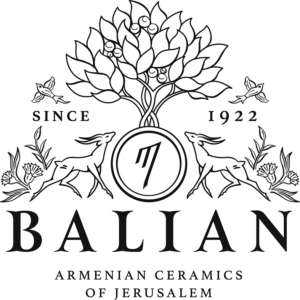FAMILY HANDS DOWN TRADITION BY DESIGN
Chicago Tribune . Chicago, Ill.; Dec 16, 1988; Stephen Franklin
Copyright Chicago Tribune Co. Dec 16, 1988
The Armenians, who today number about 2,500 here, are among Jerusalem’s oldest residents, dating from the time of Christ. Many still live within the quaint stone courtyards of the Armenian Quarter that were marked last week with black flags in honor of the earthquake victims in Soviet Armenia.
But the Armenian potters came to Jerusalem by chance, and not especially to join their brethren.
Seventy years ago, the tiles on the Dome of the Rock mosque in the Old City were in serious disrepair, and Jerusalem’s British military governor, as well as a committee of concerned citizens, set out to hire the best potters in the Middle East to repair them.
They found David Ohannessian, an Armenian potter in Kutahya, Turkey, who was a master at the art, which had been centered there since the 15th Century. Ohannessian recruited Karakashian’s father, a veteran painter, a master potter named Nishan Balian, and 10 other Armenian workers to join him in Jerusalem.
Their plans to restore the Dome of the Rock were put off, however, for monetary and other reasons. Eventually, Ohannessian opened a shop in the Old City and found a market selling dishes, tiles and pots in the colorful designs to the British and wealthy local residents.
Within a few years, his two top assistants, Nishan Balian and Karakashian’s father, opened their own store in a combined workshop and home on Nablus Road just outside the Old City. The partners and their families prospered there for 40 years until the founders died.
The sons ended the partnership, although they remained friends. Stepan and Berge Karakashian moved to their current shop on the ancient Via Dolorosa, and Setrak Balian and his French-born wife, Marie, stayed on in the old location.
Balian took up his father’s love of working at a potter’s wheel, designing fragile vases from chunks of clay just as Karakashian inherited his father’s love of colors and designs.
In the workshop located almost on the old dividing line between Arab and Jewish Jerusalem, and which was destroyed by the fighting in 1948 and 1967, Balian easily remembers his greatest pleasure from the years of work.
They were the times, says the 66-year-old potter, who has not worked with clay for several years because of a loss of control of one of his hands, that he would sit at the potter’s wheel, like his father, and become lost in his work.
“You would stand back and you would look at it. And the attachment was so great. You would take another look and start all over,” says Balian, whose son Nishan is a ceramic engineer and will be next to run the business.





